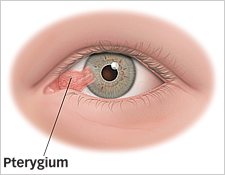Pterygium (pronounced tur-IJ-ee-um) and pinguecula (pronounced pin-GWEK-yoo-la) are growths on the cornea (the clear front window of the eye) and the conjunctiva—the thin, filmy membrane that covers the white part of your eye (sclera).
Both types of growths are believed to be caused by dry eyes and environmental elements such as wind, dust and ultraviolet light (UV).
What is the Difference Between a Pterygium and a Pinguecula?
A pterygium is a growth of fleshy tissue on the conjunctiva that extends over the cornea. This growth may remain  small or grow large enough to interfere with vision.
small or grow large enough to interfere with vision.
A pinguecula is a yellowish patch or bumps on the conjunctiva, most often on the side closest to the nose. It is a change in the normal tissue that results in a deposit of protein, fat, and/or calcium. It is similar to a callus on the skin.
Symptoms of both pterygium and pinguecula can range from mild to severe and may include:
- redness and/or inflammation – especially during the growth of a pterygium
- blurred vision
- irritation
- dryness
- itching
- burning
- gritty feeling
- the feeling of having foreign material in your eye
How are Pterygium and a Pinguecula Treated?
In many cases, no treatment is needed. When a pterygium or pinguecula becomes red and irritated, eye drops or ointments may be used to help reduce inflammation. If the growths become large enough to threaten sight or cause persistent discomfort, they can be removed surgically. They are also sometimes removed for cosmetic reasons.
Despite proper surgical removal, pterygium or pinguecula may return. Surface radiation or medications are sometimes used to help prevent recurrences. However, the best way to avoid recurrences is to limit exposure to the environmental factors that contribute to their growth. This includes:
- adequately protect your eyes from excessive UV light with proper sunglasses
- protecting your eyes in dry, dusty conditions with proper eyewear
- applying artificial tears to your eyes in dry conditions.
What Causes A Pterygium?
Although the exact cause of pterygia is still unknown, the following seems to play a crucial role in the development of the condition.
Direct exposure to harmful UV rays
You’ll be at a higher risk of exposure if you’re a construction worker, landscaper, fisherman, farmer, and if you engage in sports like sailing, golf, and surfing without wearing protective eyewear.
- Chronic irritation resulting from dry weather conditions
- Risk factors such as tear film abnormalities and human papillomavirus
- Sand, dust, smoke, wind, and pollen
- Genetic factors, although this is rare
Are There Any Symptoms of Pterygia?
Usually, the symptoms of pterygia are not severe. Most patients complain of many symptoms, including:
- Blurry or decreased vision
- Irritation or redness of the eye
- Feeling like there is something foreign in the eye
- Appearance of a raised red, pink, or white lesion on the eye
The symptoms described above might not actually mean that you have pterygia. But if you’re having one or more of these symptoms, you’ll need to see your ophthalmologist for a thorough eye exam.
How is Pterygium Diagnosed?
Your eye doctor can diagnose pterygium through a slit-lamp exam. This enables close-up observation of the area under magnification.
This exam is, in most cases, enough to make an accurate diagnosis. The eye doctors at Shepherd Eye Center recommend a comprehensive eye examination to rule out an eye tumor. If other tests are necessary, they can include the following:
Visual Acuity Testing
Your eye doctor can ask you to read specific lines on an eye chart to confirm if the pterygium is interfering with your vision.
Corneal Topography
This measures the cornea curvature to check for changes.
Photo Documentation
If your pterygium is under observation, your ophthalmologist can track its growth with photo documentation.
How Is A Pterygium Treated?
A pterygium is treated in several ways, depending on how severe it is. Patients with milder symptoms can be given over-the-counter eye drops or ointments for irritation, redness, swelling, or itchiness. Surgery may be necessary to remove the pterygium if:
- You’re unable to move your eye normally
- You have severe irritation that won’t disappear, even with other treatment options
- The growth is becoming larger or causing vision problems
- How your eyes look bothers you
Your vision is precious and irreplaceable. It’s crucial to take action if you have pterygium so that the specialists at Shepherd Eye Center can evaluate and diagnose you.
The eye doctors at Shepherd Eye Center have extensive experience treating pterygium. If you think you have pterygium, it’s important to schedule a consultation with Shepherd Eye Center in Las Vegas, NV!


